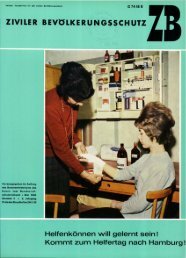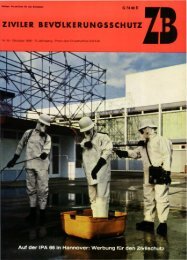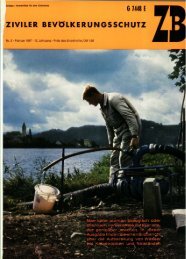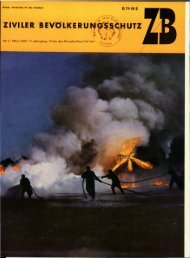Zivilschutz- Forschung - Bundesverwaltungsamt
Zivilschutz- Forschung - Bundesverwaltungsamt
Zivilschutz- Forschung - Bundesverwaltungsamt
Erfolgreiche ePaper selbst erstellen
Machen Sie aus Ihren PDF Publikationen ein blätterbares Flipbook mit unserer einzigartigen Google optimierten e-Paper Software.
126. McLaughlin, S. B. (1998). „Lethal weapons. Can you handle hazardous<br />
materials incidents?“ Health Facil Manage 11(12): 42, 44.<br />
127. Mellins, R. B. (1975). „Respiratory complications of smoke inhalation in<br />
victims of fires.“ J Pediatr 87(1): 1-7.<br />
128. Merriman, M. (1990). „Emergency medical response teams react swiftly to<br />
Phillips plant tragedy.“ Occup Health Saf 59(3): 32-6.<br />
129. Michel, P., O. Attree, et al. (2000). „[Natural biological risks and military<br />
biological risks].“ Ann Pharm Fr 58(1): 29-34.<br />
130. Moles, T. M. (1999). „Emergency medical services systems and HAZMAT<br />
major incidents.“ Resuscitation 42(2): 103-16.<br />
131. Munro, N. B., A. P. Watson, et al. (1990). „Treating exposure to chemical<br />
warfare agents: implications for health care providers and community emergency<br />
planning.“ Environ Health Perspect 89: 205-15.<br />
132. Murlidhar, V. (1994). „The Bhopal tragedy.“ Natl Med J India 7(3): 150-1.<br />
133. Murti, C. R. (1991). „Industrialization and emerging environmental health<br />
issues: lessons from the Bhopal disaster.“ Toxicol Ind Health 7(5-6): 153-64.<br />
134. Musiichuk Iu, I. (1997). „[Chemical accidents and organization of medical<br />
services].“ Med Tr Prom E-kol(6): 27-30.<br />
135. Nemery, B. (1996). „Late consequences of accidental exposure to inhaled<br />
irritants: RADS and the Bhopal disaster.“ Eur Respir J 9(10): 1973-6.<br />
136. Ochsner, M. G., J. D. Harviel, et al. (1992). „Development and organization<br />
for casualty management on a 1,000-bed hospital ship in the Persian Gulf.“<br />
J Trauma 32(4): 501-12; discussion 512-3.<br />
137. Okumura, T., K. Suzuki, et al. (1998). „The Tokyo subway sarin attack:<br />
disaster management, Part 2: Hospital response.“ Acad Emerg Med 5(6):<br />
618-24.<br />
138. Okumura, T., K. Suzuki, et al. (1998). „The Tokyo subway sarin attack:<br />
disaster management, Part 1: Community emergency response.“ Acad Emerg<br />
Med 5(6): 613-7.<br />
139. Oliveira, A. R., J. G. Hunt, et al. (1991). „Medical and related aspects of the<br />
Goiania accident: an overview.“ Health Phys 60(1): 17-24.<br />
140. Olson, K. R. (1998). „Hazmat-o-phobia. Why aren't hospitals ready for chemical<br />
accidents?“ West J Med 168(1): 32-3.<br />
141. Palmer, S. R., H. Rees, et al. (2000). „Major chemical incidents: bridging the<br />
occupational – public health gap.“ Occup Med (Lond) 50(4): 221-5.<br />
142. Palmisano, C. (2000). „Terrorism: hazmat bug for the new millennium.“<br />
QRC Advis 16(6): 10-2.<br />
143. Percival, R. (2001). „Has the world forgotten Bhopal?“ Lancet 357(9258):<br />
810.<br />
144. Perrotta, D. (2000). „It could happen here.“ Tex Med 96(3): 36.<br />
145. Peters, W. J. (1981). „Inhalation injury caused by the products of combustion.“<br />
Can Med Assoc J 125(3): 249-52.<br />
229

















